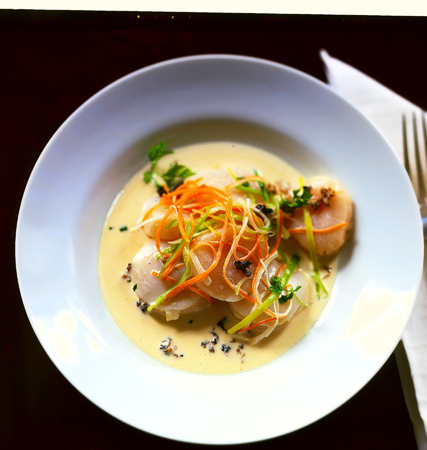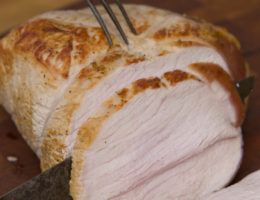by James Peterson
A French Approach to the Classics
In Glorious French Food, James Peterson explores the essential ingredients, techniques, and recipes of French cooking to uncover the underlying principles and connections that have helped define its unique culinary traditions. Through this broadened perspective, he shows cooks how to move beyond recipes and bring the spirit and techniques of French cooking to their own special dishes. Comprehensive in scope and scale, Glorious French Food can help everyone acquire a deeper understanding of French food and become a better cook in the process.
Peterson begins with classic French recipes that embrace the full range of French cooking styles, from cuisine classique to bistro cooking to nouvelle cuisine. He “gets inside” each basic recipe to reveal the essence of the dish through its history, evolution, ingredients, and preparation techniques. Then he shows how to use this knowledge to create delicious new dishes that are faithful to the spirit of the original recipe, but also distinctive and fresh.
In Peterson’s hands, timeless Duck a l’Orange gives rise to the subtle Salad of Sauteed or Grilled Duck Breasts and Sauteed Duck Breasts with Classic Orange Sauce, while traditional Cheese Souffle blossoms into stunning Individual Goat Cheese Souffles and Twice-Baked Mushroom Souffles with Morel Sauce. He also charms sweet tooths with such delightful desserts as Ginger Pots-de-Creme and Orange-Flavored Creme Caramel, both derived from classic Creme Brulee.

Infused with Peterson’s characteristic wit, warmth, and easy conversational style, Glorious French Food is as delicious to read as it is to cook from. Filled with exciting recipes and ideas, it is an irresistable resource for everyone who enjoys French cooking at its glorious best.
Book Excerpt
Beurre Blanc and Other Sauces
Sometimes called beurre nantais (after the city of Nantes, where it supposedly originated), beurre blanc–a light, creamy sauce made almost entirely with butter–was once rarely known outside Brittany. In the 1960s, a restaurant was opened by a certain Mere Michel, who whipped it up as a sauce for poached fish. Before and during Madame Michel’s restaurant reign, preparing a beurre blanc was considered beyond the abilities of mere mortals. The late Richard Olney, in his great book Simple French Food, describes the attitude of the times: “The utter simplicity of the thing, the paucity of elements, the absence of a binder…have engendered a wariness, distrust, or unbelief, than which there are no solider foundations on which to construct a myth. The story goes that only a very special kind of culinary genius with an inborn and mysterious twist of the wrist can produce a successful beurre blanc…” After reading this passage, over 30 years ago, I walked over to the stove and, following Richard’s recipe and encouragement, whipped up my first beurre blanc–perhaps the easiest sauce I’d made until then or have made since.
To understand a beurre blanc, you need to know that it and most sauces are emulsions and that emulsions are mixtures of two liquids that normally won’t combine. In other words, you can shake vinegar and oil together as long as you like, but you’ll never end up with vinaigrette. To get the two to combine, you need an emulsifier, a substance–usually a protein–that attaches itself to microscopic globules of whatever it is you’re trying to emulsify. In a mayonnaise, for example, molecules of a phospholipid found in egg yolks attach themselves to globules of oil in such a way that the globules can’t coalesce into larger globules that then float to the top of the mixture, causing it to separate. Other emulsifiers are mustard, which emulsifies a vinaigrette; vegetable purees; and the proteins contained in butter. Flour and other starches also act as emulsifiers, although in a somewhat different way.
When butter is whisked with a small amount of liquid, the proteins–sometimes called milk solids–coat the minute particles of fat and keep the butter from turning oily. Emulsions also require a small amount of liquid–water, lemon juice, flavorful meat extracts such as jus or broth–to provide a medium for the emulsifier-coated globules of fat. If the proportion of liquid is too low, the fat globules are forced together and, despite being coated with an emulsifier, will coalesce and the mixture will separate. A beurre blanc or hollandaise sauce will also break if allowed to boil, because the integrity of the proteins that maintain the emulsion is compromised; the protein “denatures” and the sauce breaks or curdles.
So when making a beurre blanc, you need only to avoid letting it boil (although, unlike for a hollandaise sauce, boiling for a few seconds won’t hurt it) and prevent the proportion of butter to liquid from getting too high. A successful beurre blanc should be only slightly thicker than cold heavy cream; if you try to make it thick, like a bechamel or reduced cream sauce, it will break.
When cooks like myself discovered that making a beurre blanc wasn’t so hard after all, there arose a plethora of variations–e.g., ginger, grapefruit–most of which have, happily, fallen into desuetude. But the technique of whisking butter into a concentrated and flavorful reduction, a technique that has come to be called monter au beurre, changed French sauce-making so that many of the classic brown sauces, instead of being thickened with flour, are now finished with varying amounts of butter, which gives them a silky body and a luxurious flavor.

